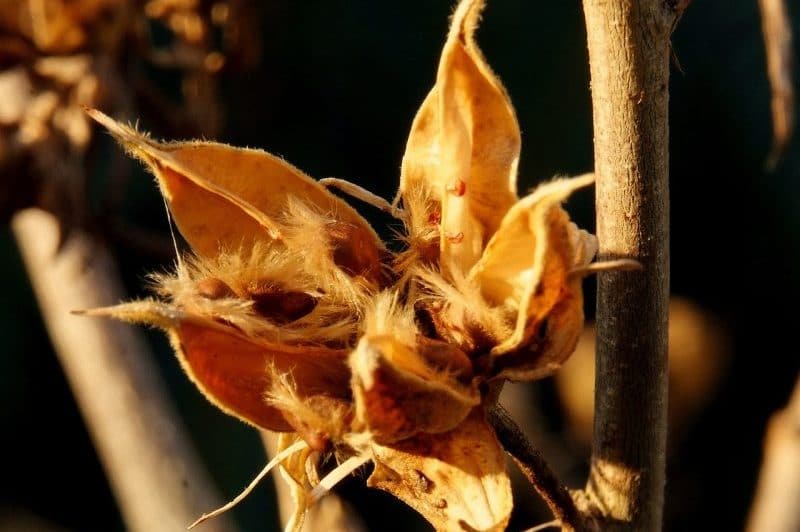Knowing how to get hibiscus seeds will always be useful, and you’ll only need four steps to master it. While you can grow hibiscus from cuttings, you might have pods that you can collect and grow from seeds themselves. A gardener that can comfortably propagate hibiscus from either cuttings or seeds will have a more productive garden year-round.
More so, germinating hibiscus seeds themselves are not complicated. You should develop healthy hibiscus seedlings for transplanting, especially when you have a greenhouse. Remember that germination and rooting is more comfortable to achieve under controlled conditions, and a greenhouse makes this possible.

Comprehensive Guide On How To Get Hibiscus Seeds
Step #1. Waiting
Collecting hibiscus seeds is easy, but it requires patience. You’ll start waiting on your seed pods by the end of the summer when you still have healthy blooms. This way, you can mark the plants that you plan on collecting the seed pods from.
The blooms will eventually wilt and die by the end of the season, which will indicate the formation of seed pods. You’ll see them at the base of each bloom, but wait for them to ripen before harvesting. The pods should turn brown, but you want to harvest them before they burst and expel the seeds.
If you’re not sure that you can collect them on time, you can avoid wasting seeds by adding a netting on your plants to catch the seeds. As mentioned earlier, you want to wait for the seed pods to turn brown. However, you want to collect them before they burst open.
Step #2. Gathering
You can collect the hibiscus seed pods as you would with other plants. Place a sack under each bloom to catch the seeds as you shake them. You may have to break the pod open yourself in some cases, and you can do this with your fingers.
How many seeds are you expecting with each bloom? The number can vary from 10 to 100, so always collect as much as you can for sowing. The healthy seeds should look round, fuzzy, and dark brown.
Step #3. Drying
After collecting the seeds, you can store the paper sack somewhere dry that has adequate ventilation. You can use a greenhouse to keep the seeds until you can start planting and help them dry completely. After about a week, you can pour and have them in a single layer onto a tray to remove plant debris from the seeds.
Step #4. Storage
After you have dried the seeds and removed all the plant debris, you can transfer them onto a paper envelope for storage. Don’t forget to label this with the date of collection before placing it in a cool dry place until planting in spring. However, be prepare to stratify your seeds unless you are using tropical hibiscus.
Remember that hibiscus seeds have a hard outer coating that you will need to break to encourage germination. You can stratify them by putting the seeds in the freezer, but you can also naturally break the tough coating by storing them outside during winter.
How To Grow Hibiscus
You can sow hibiscus seeds in your favorite seed-starting mix. Some gardeners use seed trays, but you can also use any container if you aren’t planting many seeds. You also want to water the medium first to get it moist before planting.
A depth around half an inch is enough for the seeds, and you can place the container on a heat mat to help with germination. It might be more comfortable to set the seeds in the greenhouse and keep the temperatures warm more comfortably. Then, cover the tray and keep the mix moist.
Once the seeds sprout, remove the cover and place the containers under grow lights to help the plants grow further. Thin the seedlings once they develop leaves and feed them with a diluted water-soluble fertilizer. You can keep them indoors, but you can also transplant them outside once the danger of frost has passed.
Caring For Hibiscus
Hibiscus plants should thrive well in fertile and well-draining soil. You can also test the soil and ensure that it is slightly acidic. Full sun is supportive of hibiscus health, but opt to use a greenhouse if your region experiences strong winds and harsh winter.
For feeding and watering, hibiscus can get a boost in growth and blooming with a general-purpose fertilizer. Otherwise, fertilizing isn’t necessary. On the other hand, you must keep the soil moist because these plants thrive in full sun.
A maintenance practice that works excellent for hibiscus plants is pruning. You can do this in spring to help them recover. You can also deadhead hibiscus to encourage another blooming period.
If you then need to divide your plants, you can again do it in spring.
Conclusion
Hibiscus is not only easy to grow from cuttings. You can also learn how to get hibiscus seeds for sowing in spring without any hassle. Start by checking out the blooms by the end of summer as they will eventually fade and die.
You must wait for the seed pods at their base to turn brown and then shake them onto a sack. You might also need to open the pod yourself to collect the hibiscus seeds. Finally, let them dry for a week somewhere dry with adequate ventilation before storage in a paper envelope for use in spring.
